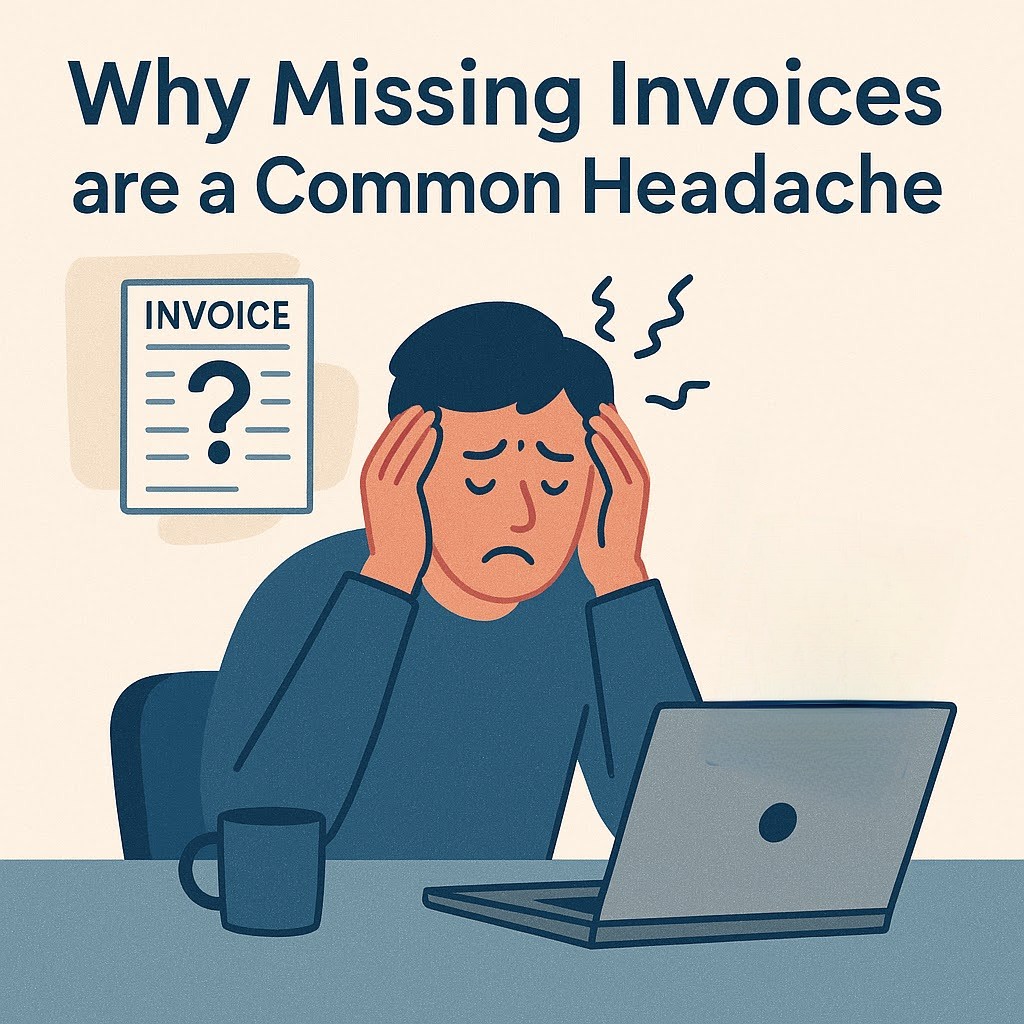Create Missing Invoices Fast: 4-Step Method & Key Pitfalls
Remember the fintech roundtable last quarter when everyone groaned at the phrase “missing invoice”? I do—because I was the one waving a printout of a supplier ledger with twelve blank spots. The room went silent until Maria, our controller, snapped, “We need a triage protocol—yesterday.” That moment shaped the framework we now teach clients: trace, rebuild, validate, archive. Four verbs, one objective—zero loose ends.

First, trace the transaction. Before you chase a supplier, squeeze your own data. Bank feed, Slack thread, project-management card—some breadcrumb always surfaces. Just last week a SaaS startup found eight “lost” invoices hiding in a shared Gmail label. The whole hunt took 14 minutes because we asked the right questions upfront.
Second, rebuild fast. If the supplier is ghosting you or operating on dial-up (yes, still happens), spin up a compliant replacement in seconds. I keep InvoiceGenie’s one-page generator bookmarked; it pre-loads tax fields and auto-numbers based on our fiscal calendar. Compare that to wrestling with a legacy ERP template—no contest.
Third, validate before you hit “send.” Compliance rules tightened again after the latest EU e-invoicing directive, and auditors are laser-focused on currency conversion math. My trick? Feed the draft through a simple OCR loop—even if it’s born digital. The text-layer check catches misspelled legal entities and mismatched VAT IDs that slip human review.
Finally, archive intelligently. Dumping PDFs into a network drive is asking for another scavenger hunt. We set up a webhook that pushes finalized invoices to both our cloud repository and the audit folder, renaming each file with supplier code + invoice date. Month-end close shrank from six days to four, and our auditors now “sample” 100% with a smile.
Is this overkill? Possibly. But when the tax inspector rings your doorbell in Q4, you’ll wish you’d gone further.
Now, you might be thinking, “Great framework, but my suppliers barely answer emails—how am I supposed to ‘trace’ anything?” Fair point. I’ve dealt with a German OEM that took three weeks to acknowledge a missing €7,800 invoice. In that gap, we still rebuilt internally, but we also flagged it as provisional in the ledger. The trick is treating it like a contingent liability—if the supplier eventually shows up with a conflicting doc, you reverse the provisional and attach the real one. Yes, it’s an extra journal entry; it’s also what saved us from a nasty double-count during audit.
But here’s the thing: relationship politics can get messy. Strong-arming a strategic vendor may jeopardize next quarter’s discount. My go-to move is a friendly “compliance nudge”—I quote the tax authority’s statutory retention rules and copy their accounts team. Nine times out of ten, they cough up the PDF within 24 hours. The one outlier? A boutique dev shop in Argentina still issuing carbon-copy invoices. We ended up hiring a local runner to scan and email them—painful, but cheaper than non-deductible VAT.
Another objection I hear is, “Multi-currency ruins any quick-fix workflow.” Totally valid—FX swings can turn a $0.01 rounding error into a reconciliation nightmare. What we’ve done is lock the exchange rate the moment the purchase order closes, not when the invoice lands. That single policy change sliced our FX variances by 70% last fiscal year.
And let’s debunk the chestnut that “It’s easier to clean this up at year-end.” Ask anyone who’s survived a surprise audit: year-end is precisely when every spreadsheet gremlin comes alive. Spreading the cleanup across 12 micro-cycles keeps the noise low and the auditors bored (which is exactly how you want them).
When we kicked things off, I asked why missing invoices still ambush even the most digital-first finance teams. Four sections later, the answer feels almost embarrassingly simple: the money moves, the goods land, the paperwork just fails to show up on time—and our systems aren’t built to forgive that lapse.
So what’s the upshot? We design workflows that assume forgetfulness. We tag every purchase order like evidence in a procedural drama—timestamped, version-controlled, and locked in a vault someone actually audits. We steal habits from DevOps (automate repetitive tasks) and sprinkle in a bit of diplomacy (gentle nudges before legal threats). Tiny tweaks, big dividends.
Here’s a thought experiment for your next coffee break: pick one supplier, one project, one petty-cash transaction—whatever feels safe to poke. Run the four-verb drill we covered: trace, rebuild, validate, archive. Clock yourself. Where did you stall? Which colleague held the missing puzzle piece? That choke point is your next optimization ticket, no purchase order required.
And don’t underestimate the ripple effect of shaving twenty minutes off an “invoice hunt.” Those reclaimed cycles add up, lubricating month-end close, muting auditor curiosity, and—let’s be honest—reducing the odds of a frantic Slack message at 11:57 p.m. titled “URGENT: Need Invoice NOW.”
Frequently Asked Questions
1. What’s the quickest way to put the “trace, rebuild, validate, archive” workflow from “How to Create Missing Invoices Without the Headache” into practice?
Start small. Grab one low-risk transaction and walk it through the four verbs. As we explained in the Re-Create or Recover? Picking the Right Route for Each Scenario section, you’ll spend most of your time on the trace step—so set a timer, identify the bottleneck, and tweak that process first. Rinse, repeat, scale.
2. How does the “Re-Create or Recover?” decision matrix handle multi-currency invoices?
Multi-currency situations add an FX layer between rebuild and validate. Lock the exchange rate at purchase-order close (not invoice date) and note that policy inside your ERP. This mirrors the advice in the When Real-World Friction Kicks In: Counterpoints & Common Hurdles heading, where we cut FX variance by 70 percent last year.
3. My supplier is still mailing carbon-copy slips. Does the article’s “counterpoints” section really solve that?
Yep. In When Real-World Friction Kicks In we shared the anecdote about hiring a local runner to scan those carbon copies. Not glamorous, but it balanced relationship equity with compliance. Bottom line: meet your supplier where they are, then digitize on your side.
4. Is hiring a courier runner actually cheaper than waiting for year-end reconciliation?
Surprisingly, yes. A one-off courier fee often beats the cumulative cost of late-payment penalties, VAT disallowances, or overtime during a frantic “heroic sprint” at year-end—exactly the nightmare we cautioned against in Putting It All Together: Keep the Paper Trail from Turning into a Crime Scene.
5. Where can I find additional playbooks if I still feel exposed to cash leaks?
If you want deeper dives beyond this article, check out the 14-step roadmap over at Missing Invoices: 14 Proven Fixes to Stop Cash Leaks. It expands on several tactics mentioned in How to Create Missing Invoices Without the Headache and offers more granular checklists you can bolt onto your current workflow.

